Analysis of Energy Consumption Challenges in Western Australia Report
VerifiedAdded on 2020/04/29
|16
|3617
|69
Report
AI Summary
This report investigates the challenges of energy consumption in Western Australia (WA), particularly focusing on household appliances and their environmental impact. It highlights the significant energy usage of appliances like freezers and air conditioners and the need for sustainable development. The report details the appliances used in Australian households, identifying the major energy consumers and their associated costs. It explores the role of organizations like the Energy Efficiency Council and the Department of Environment and Energy in promoting energy efficiency through various programs and policies. The report emphasizes opportunities to decrease energy consumption, such as implementing energy-saving technologies and raising consumer awareness. It concludes that efficient appliance usage is crucial for reducing energy consumption, lowering costs, and conserving resources. The report also includes detailed information on specific appliances, their energy consumption, and potential alternatives to improve efficiency. Furthermore, it discusses the importance of government initiatives and technological advancements in fostering a sustainable energy future for Australia.

Running head: SUSTAINABLE DEVELOPMENT
Sustainable development
Name of the Student
Name of the University
Author note
Sustainable development
Name of the Student
Name of the University
Author note
Paraphrase This Document
Need a fresh take? Get an instant paraphrase of this document with our AI Paraphraser
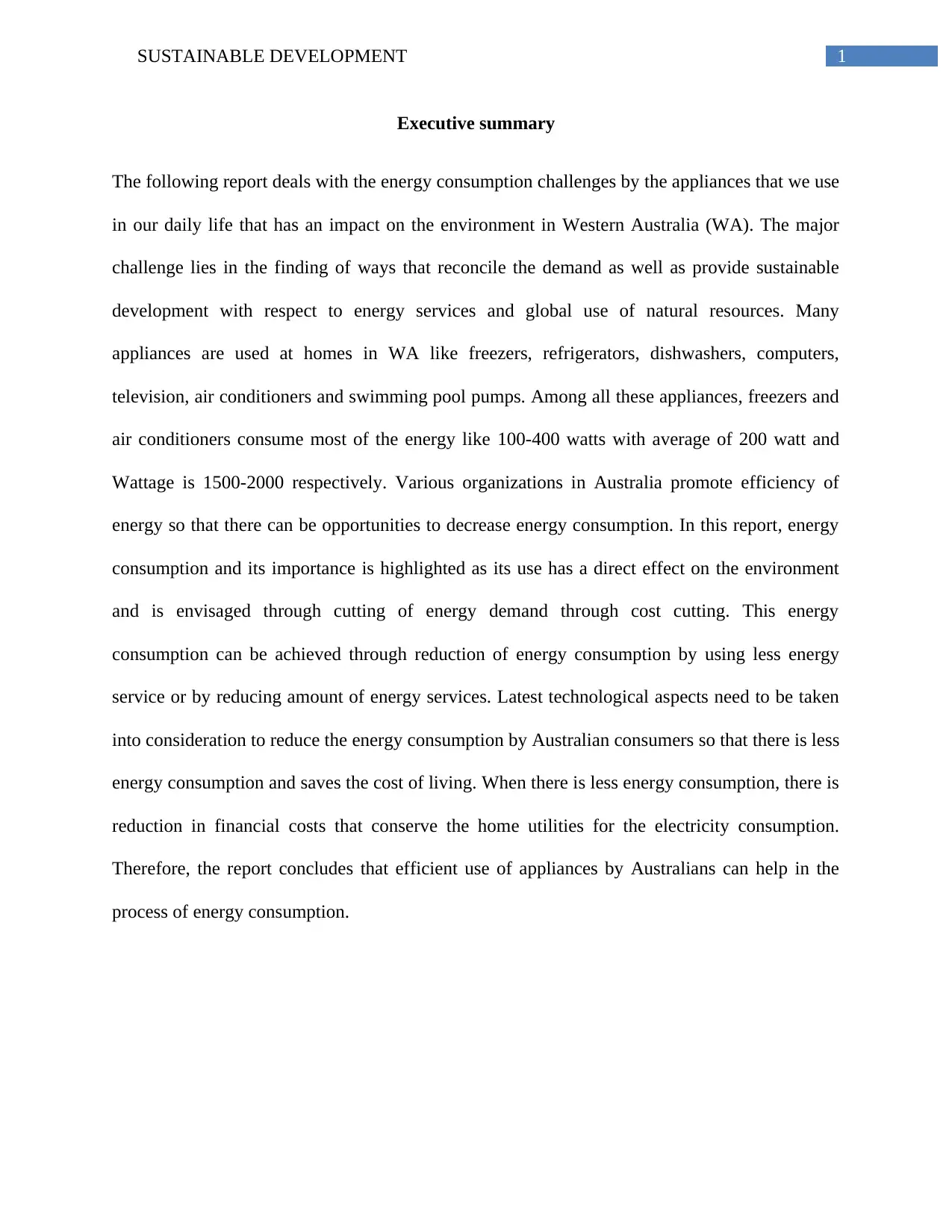
1SUSTAINABLE DEVELOPMENT
Executive summary
The following report deals with the energy consumption challenges by the appliances that we use
in our daily life that has an impact on the environment in Western Australia (WA). The major
challenge lies in the finding of ways that reconcile the demand as well as provide sustainable
development with respect to energy services and global use of natural resources. Many
appliances are used at homes in WA like freezers, refrigerators, dishwashers, computers,
television, air conditioners and swimming pool pumps. Among all these appliances, freezers and
air conditioners consume most of the energy like 100-400 watts with average of 200 watt and
Wattage is 1500-2000 respectively. Various organizations in Australia promote efficiency of
energy so that there can be opportunities to decrease energy consumption. In this report, energy
consumption and its importance is highlighted as its use has a direct effect on the environment
and is envisaged through cutting of energy demand through cost cutting. This energy
consumption can be achieved through reduction of energy consumption by using less energy
service or by reducing amount of energy services. Latest technological aspects need to be taken
into consideration to reduce the energy consumption by Australian consumers so that there is less
energy consumption and saves the cost of living. When there is less energy consumption, there is
reduction in financial costs that conserve the home utilities for the electricity consumption.
Therefore, the report concludes that efficient use of appliances by Australians can help in the
process of energy consumption.
Executive summary
The following report deals with the energy consumption challenges by the appliances that we use
in our daily life that has an impact on the environment in Western Australia (WA). The major
challenge lies in the finding of ways that reconcile the demand as well as provide sustainable
development with respect to energy services and global use of natural resources. Many
appliances are used at homes in WA like freezers, refrigerators, dishwashers, computers,
television, air conditioners and swimming pool pumps. Among all these appliances, freezers and
air conditioners consume most of the energy like 100-400 watts with average of 200 watt and
Wattage is 1500-2000 respectively. Various organizations in Australia promote efficiency of
energy so that there can be opportunities to decrease energy consumption. In this report, energy
consumption and its importance is highlighted as its use has a direct effect on the environment
and is envisaged through cutting of energy demand through cost cutting. This energy
consumption can be achieved through reduction of energy consumption by using less energy
service or by reducing amount of energy services. Latest technological aspects need to be taken
into consideration to reduce the energy consumption by Australian consumers so that there is less
energy consumption and saves the cost of living. When there is less energy consumption, there is
reduction in financial costs that conserve the home utilities for the electricity consumption.
Therefore, the report concludes that efficient use of appliances by Australians can help in the
process of energy consumption.
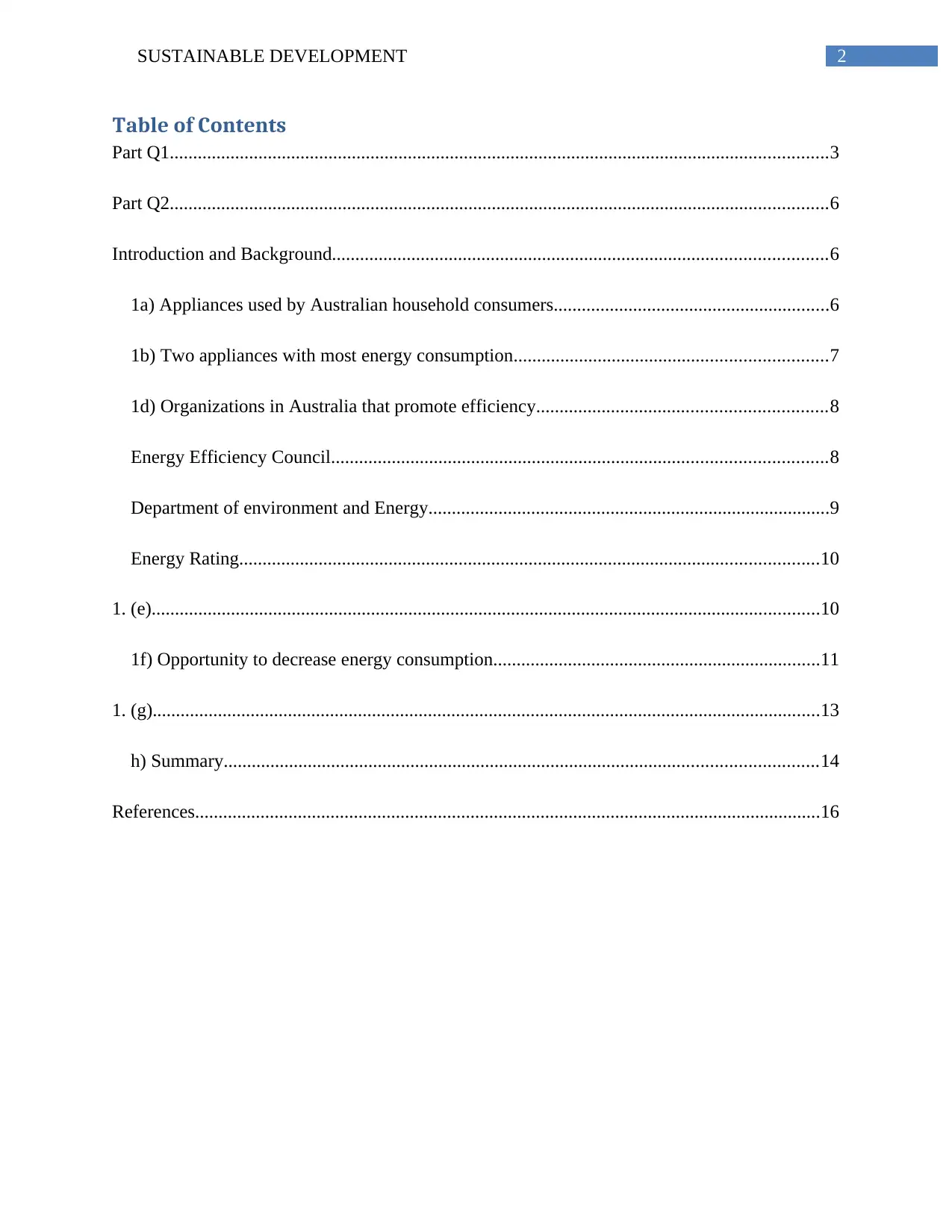
2SUSTAINABLE DEVELOPMENT
Table of Contents
Part Q1.............................................................................................................................................3
Part Q2.............................................................................................................................................6
Introduction and Background..........................................................................................................6
1a) Appliances used by Australian household consumers...........................................................6
1b) Two appliances with most energy consumption...................................................................7
1d) Organizations in Australia that promote efficiency..............................................................8
Energy Efficiency Council..........................................................................................................8
Department of environment and Energy......................................................................................9
Energy Rating............................................................................................................................10
1. (e)...............................................................................................................................................10
1f) Opportunity to decrease energy consumption......................................................................11
1. (g)...............................................................................................................................................13
h) Summary...............................................................................................................................14
References......................................................................................................................................16
Table of Contents
Part Q1.............................................................................................................................................3
Part Q2.............................................................................................................................................6
Introduction and Background..........................................................................................................6
1a) Appliances used by Australian household consumers...........................................................6
1b) Two appliances with most energy consumption...................................................................7
1d) Organizations in Australia that promote efficiency..............................................................8
Energy Efficiency Council..........................................................................................................8
Department of environment and Energy......................................................................................9
Energy Rating............................................................................................................................10
1. (e)...............................................................................................................................................10
1f) Opportunity to decrease energy consumption......................................................................11
1. (g)...............................................................................................................................................13
h) Summary...............................................................................................................................14
References......................................................................................................................................16
⊘ This is a preview!⊘
Do you want full access?
Subscribe today to unlock all pages.

Trusted by 1+ million students worldwide
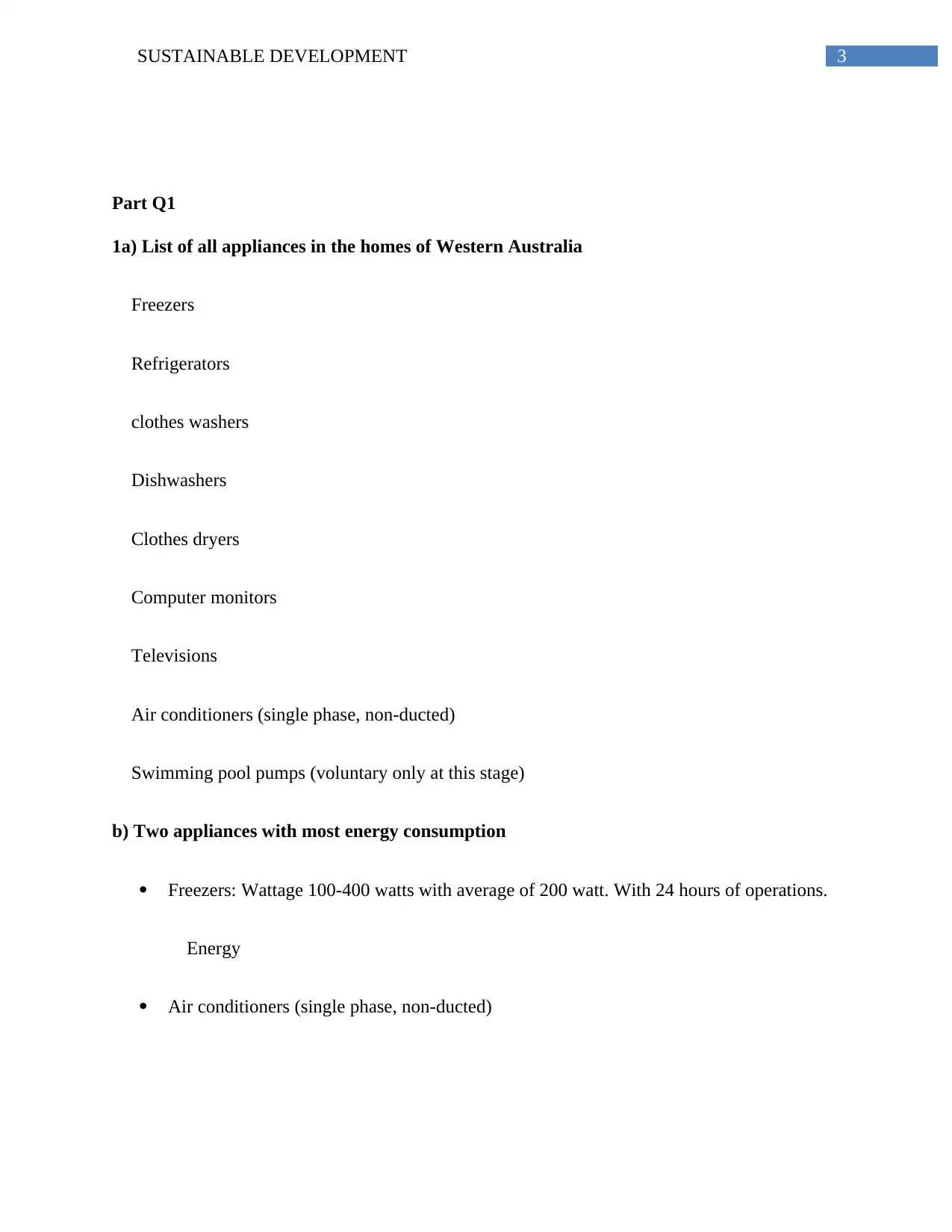
3SUSTAINABLE DEVELOPMENT
Part Q1
1a) List of all appliances in the homes of Western Australia
Freezers
Refrigerators
clothes washers
Dishwashers
Clothes dryers
Computer monitors
Televisions
Air conditioners (single phase, non-ducted)
Swimming pool pumps (voluntary only at this stage)
b) Two appliances with most energy consumption
Freezers: Wattage 100-400 watts with average of 200 watt. With 24 hours of operations.
Energy
Air conditioners (single phase, non-ducted)
Part Q1
1a) List of all appliances in the homes of Western Australia
Freezers
Refrigerators
clothes washers
Dishwashers
Clothes dryers
Computer monitors
Televisions
Air conditioners (single phase, non-ducted)
Swimming pool pumps (voluntary only at this stage)
b) Two appliances with most energy consumption
Freezers: Wattage 100-400 watts with average of 200 watt. With 24 hours of operations.
Energy
Air conditioners (single phase, non-ducted)
Paraphrase This Document
Need a fresh take? Get an instant paraphrase of this document with our AI Paraphraser
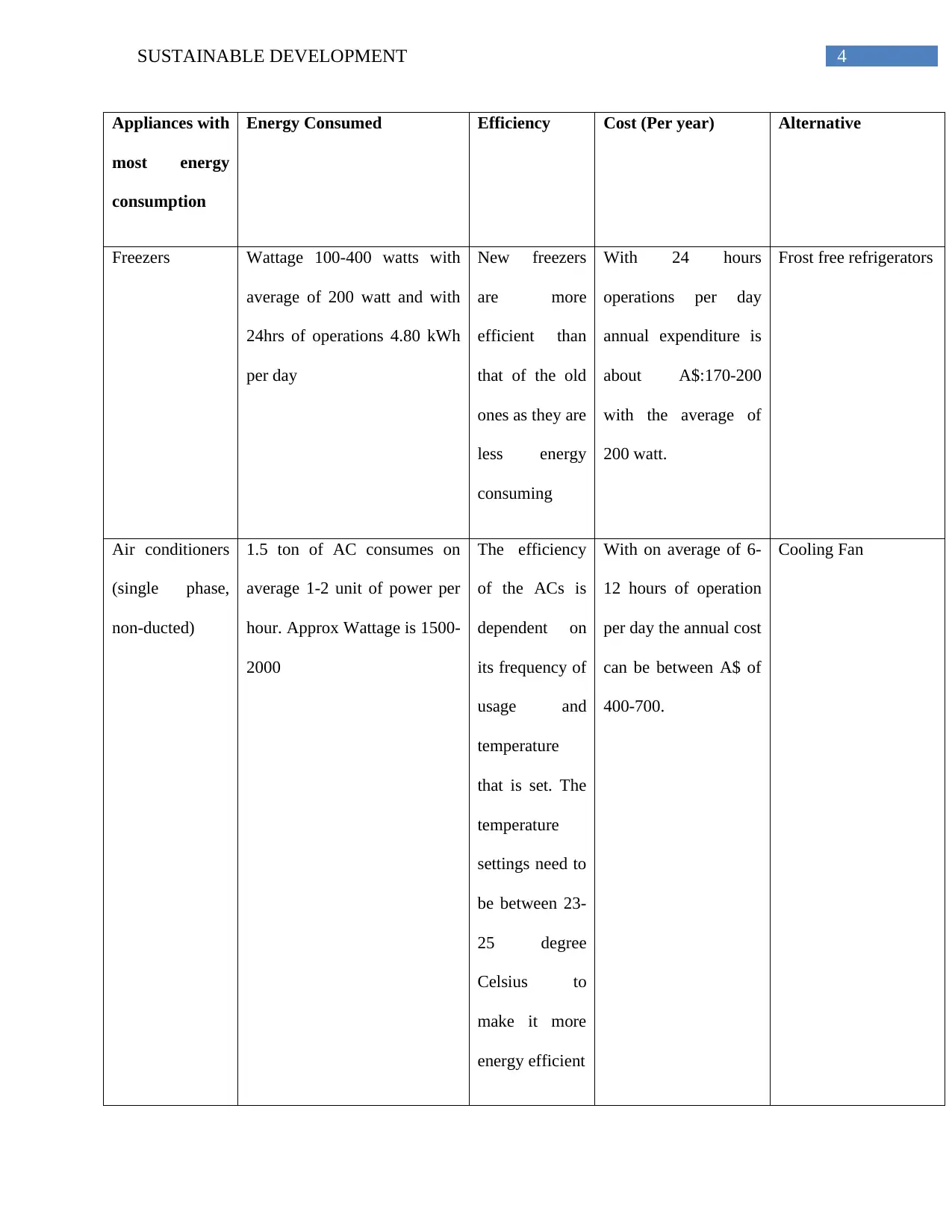
4SUSTAINABLE DEVELOPMENT
Appliances with
most energy
consumption
Energy Consumed Efficiency Cost (Per year) Alternative
Freezers Wattage 100-400 watts with
average of 200 watt and with
24hrs of operations 4.80 kWh
per day
New freezers
are more
efficient than
that of the old
ones as they are
less energy
consuming
With 24 hours
operations per day
annual expenditure is
about A$:170-200
with the average of
200 watt.
Frost free refrigerators
Air conditioners
(single phase,
non-ducted)
1.5 ton of AC consumes on
average 1-2 unit of power per
hour. Approx Wattage is 1500-
2000
The efficiency
of the ACs is
dependent on
its frequency of
usage and
temperature
that is set. The
temperature
settings need to
be between 23-
25 degree
Celsius to
make it more
energy efficient
With on average of 6-
12 hours of operation
per day the annual cost
can be between A$ of
400-700.
Cooling Fan
Appliances with
most energy
consumption
Energy Consumed Efficiency Cost (Per year) Alternative
Freezers Wattage 100-400 watts with
average of 200 watt and with
24hrs of operations 4.80 kWh
per day
New freezers
are more
efficient than
that of the old
ones as they are
less energy
consuming
With 24 hours
operations per day
annual expenditure is
about A$:170-200
with the average of
200 watt.
Frost free refrigerators
Air conditioners
(single phase,
non-ducted)
1.5 ton of AC consumes on
average 1-2 unit of power per
hour. Approx Wattage is 1500-
2000
The efficiency
of the ACs is
dependent on
its frequency of
usage and
temperature
that is set. The
temperature
settings need to
be between 23-
25 degree
Celsius to
make it more
energy efficient
With on average of 6-
12 hours of operation
per day the annual cost
can be between A$ of
400-700.
Cooling Fan
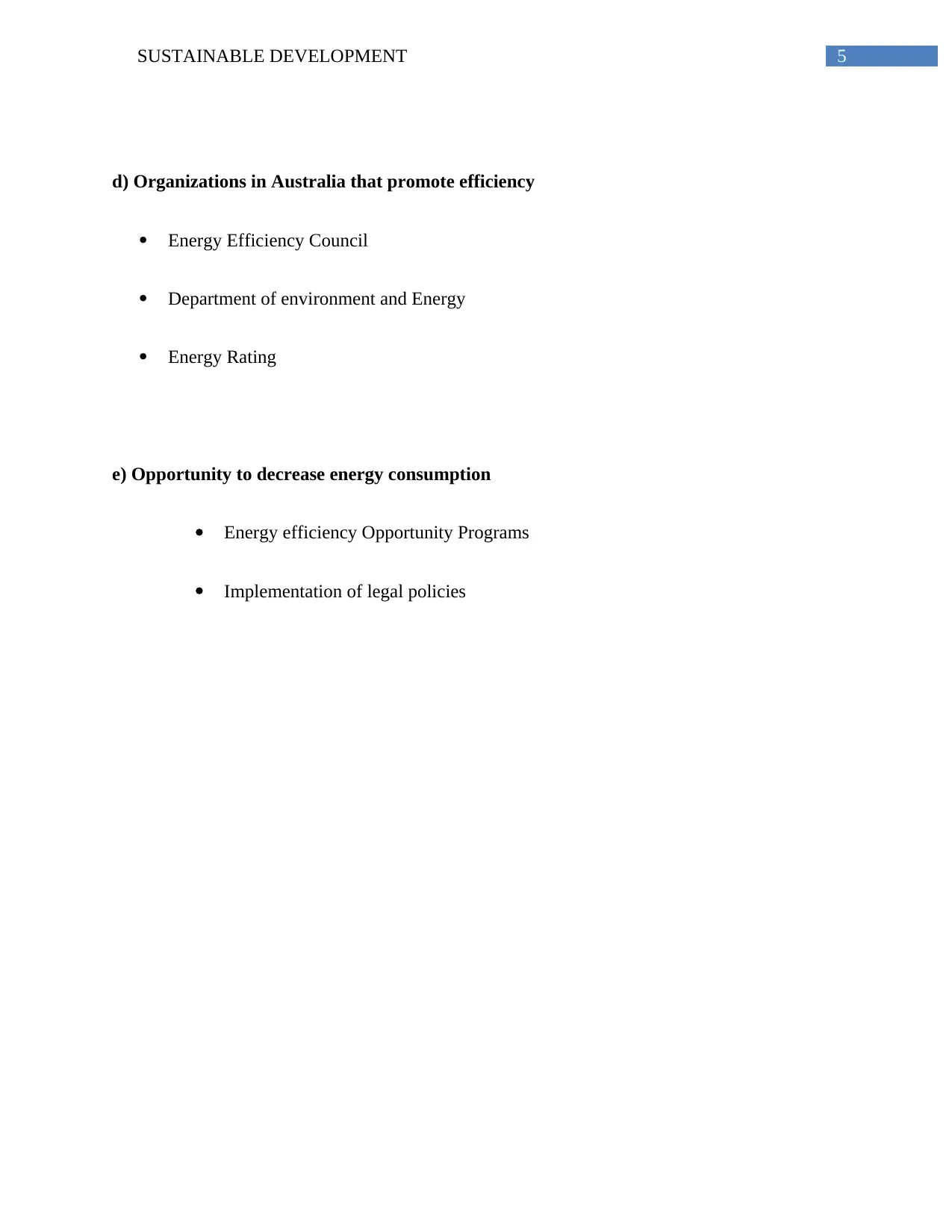
5SUSTAINABLE DEVELOPMENT
d) Organizations in Australia that promote efficiency
Energy Efficiency Council
Department of environment and Energy
Energy Rating
e) Opportunity to decrease energy consumption
Energy efficiency Opportunity Programs
Implementation of legal policies
d) Organizations in Australia that promote efficiency
Energy Efficiency Council
Department of environment and Energy
Energy Rating
e) Opportunity to decrease energy consumption
Energy efficiency Opportunity Programs
Implementation of legal policies
⊘ This is a preview!⊘
Do you want full access?
Subscribe today to unlock all pages.

Trusted by 1+ million students worldwide
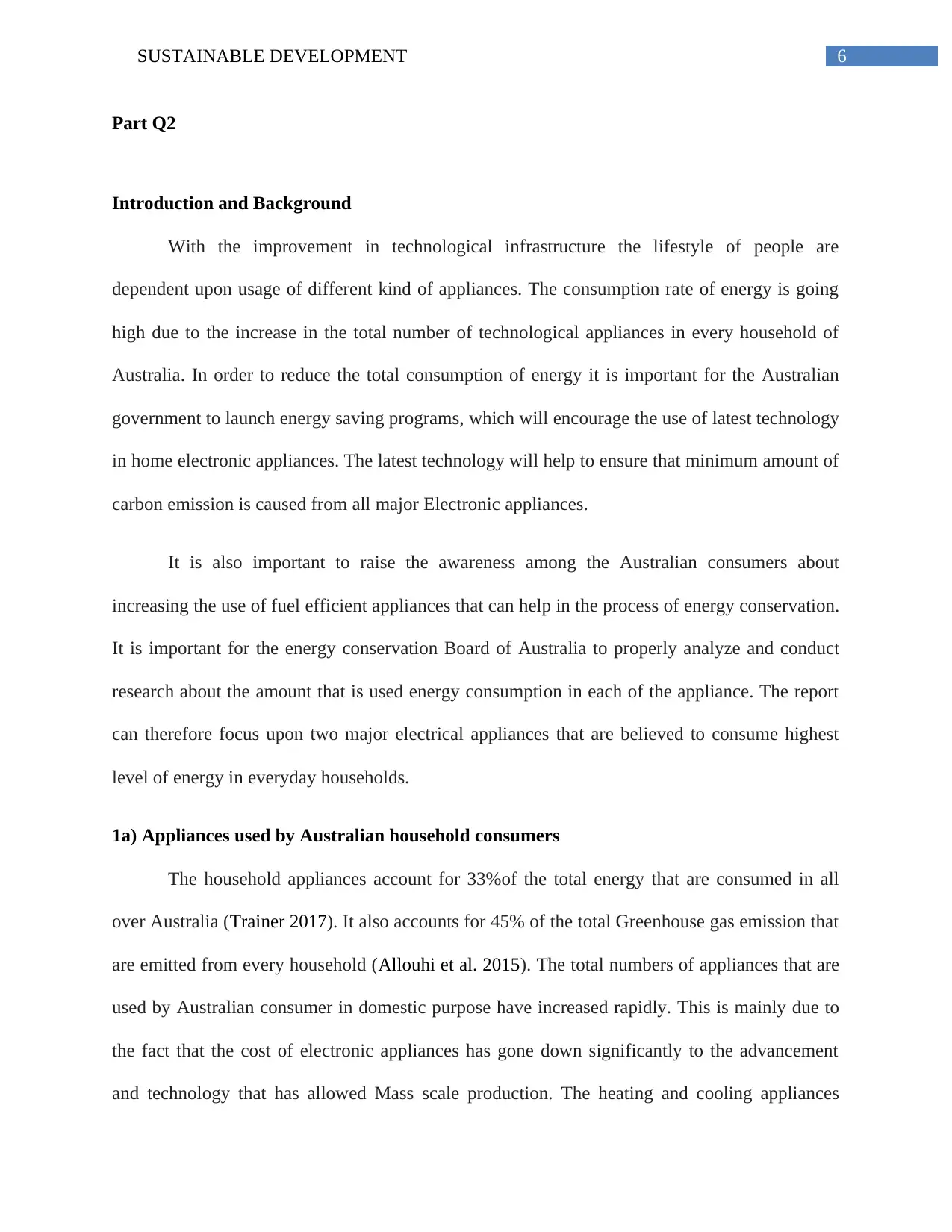
6SUSTAINABLE DEVELOPMENT
Part Q2
Introduction and Background
With the improvement in technological infrastructure the lifestyle of people are
dependent upon usage of different kind of appliances. The consumption rate of energy is going
high due to the increase in the total number of technological appliances in every household of
Australia. In order to reduce the total consumption of energy it is important for the Australian
government to launch energy saving programs, which will encourage the use of latest technology
in home electronic appliances. The latest technology will help to ensure that minimum amount of
carbon emission is caused from all major Electronic appliances.
It is also important to raise the awareness among the Australian consumers about
increasing the use of fuel efficient appliances that can help in the process of energy conservation.
It is important for the energy conservation Board of Australia to properly analyze and conduct
research about the amount that is used energy consumption in each of the appliance. The report
can therefore focus upon two major electrical appliances that are believed to consume highest
level of energy in everyday households.
1a) Appliances used by Australian household consumers
The household appliances account for 33%of the total energy that are consumed in all
over Australia (Trainer 2017). It also accounts for 45% of the total Greenhouse gas emission that
are emitted from every household (Allouhi et al. 2015). The total numbers of appliances that are
used by Australian consumer in domestic purpose have increased rapidly. This is mainly due to
the fact that the cost of electronic appliances has gone down significantly to the advancement
and technology that has allowed Mass scale production. The heating and cooling appliances
Part Q2
Introduction and Background
With the improvement in technological infrastructure the lifestyle of people are
dependent upon usage of different kind of appliances. The consumption rate of energy is going
high due to the increase in the total number of technological appliances in every household of
Australia. In order to reduce the total consumption of energy it is important for the Australian
government to launch energy saving programs, which will encourage the use of latest technology
in home electronic appliances. The latest technology will help to ensure that minimum amount of
carbon emission is caused from all major Electronic appliances.
It is also important to raise the awareness among the Australian consumers about
increasing the use of fuel efficient appliances that can help in the process of energy conservation.
It is important for the energy conservation Board of Australia to properly analyze and conduct
research about the amount that is used energy consumption in each of the appliance. The report
can therefore focus upon two major electrical appliances that are believed to consume highest
level of energy in everyday households.
1a) Appliances used by Australian household consumers
The household appliances account for 33%of the total energy that are consumed in all
over Australia (Trainer 2017). It also accounts for 45% of the total Greenhouse gas emission that
are emitted from every household (Allouhi et al. 2015). The total numbers of appliances that are
used by Australian consumer in domestic purpose have increased rapidly. This is mainly due to
the fact that the cost of electronic appliances has gone down significantly to the advancement
and technology that has allowed Mass scale production. The heating and cooling appliances
Paraphrase This Document
Need a fresh take? Get an instant paraphrase of this document with our AI Paraphraser

7SUSTAINABLE DEVELOPMENT
accounts for 40% of the total energy consumed in household purpose. Due to the cold climate of
Australian region, people are dependent on water heating appliances, which consume 21%of the
total energy. 33% of the energy is being consumed in refrigerator and cooking equipments. The
lighting appliances just consume 6% of the total energy (Smyth 2013).
There are various other kinds of luxury appliances that are used by the Australian
consumers, which include pool and Spa tank and pumps. Dishwasher, cloth dryer, cloth washer
are few of the other important appliances. There are various criteria that decide upon the type of
appliances that will be selected by the Australian consumer. The price and brands of appliances
are major factors that decide on the type of appliances purchased by the Australian consumers. It
is important to mention that due to the high income level of Australian people, it is possible for
them to use variety of electronic appliances.
1b) Two appliances with most energy consumption
Out of all the appliances, method used by Australian consumers the refrigerator and air
condition is the most energy consuming device. Refrigerator and air conditions are among the
top selling appliances of household products within Australian consumers. From the findings in
the above section, it is clear that average wattage of a typical refrigerator that is used by
Australian consumers is 200 watt.
It is also clear from the report of Australian energy Council that an average Australian
consumer operates refrigerator for 24 hours. This is due to the fact that most of the Australian
consumers are dependent upon processed food that needs to be stored in cool environment for
longer period (Wiedenhofer et al. 2013). Average energy that is consumed per day in refrigerator
he is around 4.80 kilowatt. This accounts for a total expenditure of 170 to 200 dollar per year for
accounts for 40% of the total energy consumed in household purpose. Due to the cold climate of
Australian region, people are dependent on water heating appliances, which consume 21%of the
total energy. 33% of the energy is being consumed in refrigerator and cooking equipments. The
lighting appliances just consume 6% of the total energy (Smyth 2013).
There are various other kinds of luxury appliances that are used by the Australian
consumers, which include pool and Spa tank and pumps. Dishwasher, cloth dryer, cloth washer
are few of the other important appliances. There are various criteria that decide upon the type of
appliances that will be selected by the Australian consumer. The price and brands of appliances
are major factors that decide on the type of appliances purchased by the Australian consumers. It
is important to mention that due to the high income level of Australian people, it is possible for
them to use variety of electronic appliances.
1b) Two appliances with most energy consumption
Out of all the appliances, method used by Australian consumers the refrigerator and air
condition is the most energy consuming device. Refrigerator and air conditions are among the
top selling appliances of household products within Australian consumers. From the findings in
the above section, it is clear that average wattage of a typical refrigerator that is used by
Australian consumers is 200 watt.
It is also clear from the report of Australian energy Council that an average Australian
consumer operates refrigerator for 24 hours. This is due to the fact that most of the Australian
consumers are dependent upon processed food that needs to be stored in cool environment for
longer period (Wiedenhofer et al. 2013). Average energy that is consumed per day in refrigerator
he is around 4.80 kilowatt. This accounts for a total expenditure of 170 to 200 dollar per year for

8SUSTAINABLE DEVELOPMENT
energy consumption in Australia. It is also recommended to use modern style of refrigerator
which uses Frost free Technology. This type of Technology will help to ensure that minimum
amount of energy are being consumed.
The air condition is also one of the major sources of energy expenditure. On average, the
air conditioner consumes 1500 to 2000 watt of electricity. This accounts for 1 to 2 unit of
electricity consumption per hour. On average an Australian consumers spends 400 to $700 in
electricity bill for air condition (Trainer 2017). The report from the Australian energy department
suggests that an average Australian consumer operates air condition for 6 to 12 hours in every
day. It is essential to have proper setting with an air condition device, which will help in
Optimization of the energy that is being consumed.
1d) Organizations in Australia that promote efficiency
Many energy-using companies in Australia support the development and implementation
of strategies for energy management and energy efficiency.
Energy Efficiency Council
This council is a peak body for co-generation, energy efficiency and demand
management in Australia that is aimed at making sensible, energy efficient measures that are cost
effective and measurement of standard practices that are in the Australian economy. This non-
governmental organization provides latest information about the use of less energy at business,
homes and workplaces. This organization provide a multitude of ways by which the energy
efficiency sector of Australia supports households, businesses and governments regarding wide
use of energy. It also works in the identification of energy efficiency opportunities at specific
sites and buildings and work with clients in improving equipments, facilities, behaviour and
energy consumption in Australia. It is also recommended to use modern style of refrigerator
which uses Frost free Technology. This type of Technology will help to ensure that minimum
amount of energy are being consumed.
The air condition is also one of the major sources of energy expenditure. On average, the
air conditioner consumes 1500 to 2000 watt of electricity. This accounts for 1 to 2 unit of
electricity consumption per hour. On average an Australian consumers spends 400 to $700 in
electricity bill for air condition (Trainer 2017). The report from the Australian energy department
suggests that an average Australian consumer operates air condition for 6 to 12 hours in every
day. It is essential to have proper setting with an air condition device, which will help in
Optimization of the energy that is being consumed.
1d) Organizations in Australia that promote efficiency
Many energy-using companies in Australia support the development and implementation
of strategies for energy management and energy efficiency.
Energy Efficiency Council
This council is a peak body for co-generation, energy efficiency and demand
management in Australia that is aimed at making sensible, energy efficient measures that are cost
effective and measurement of standard practices that are in the Australian economy. This non-
governmental organization provides latest information about the use of less energy at business,
homes and workplaces. This organization provide a multitude of ways by which the energy
efficiency sector of Australia supports households, businesses and governments regarding wide
use of energy. It also works in the identification of energy efficiency opportunities at specific
sites and buildings and work with clients in improving equipments, facilities, behaviour and
⊘ This is a preview!⊘
Do you want full access?
Subscribe today to unlock all pages.

Trusted by 1+ million students worldwide
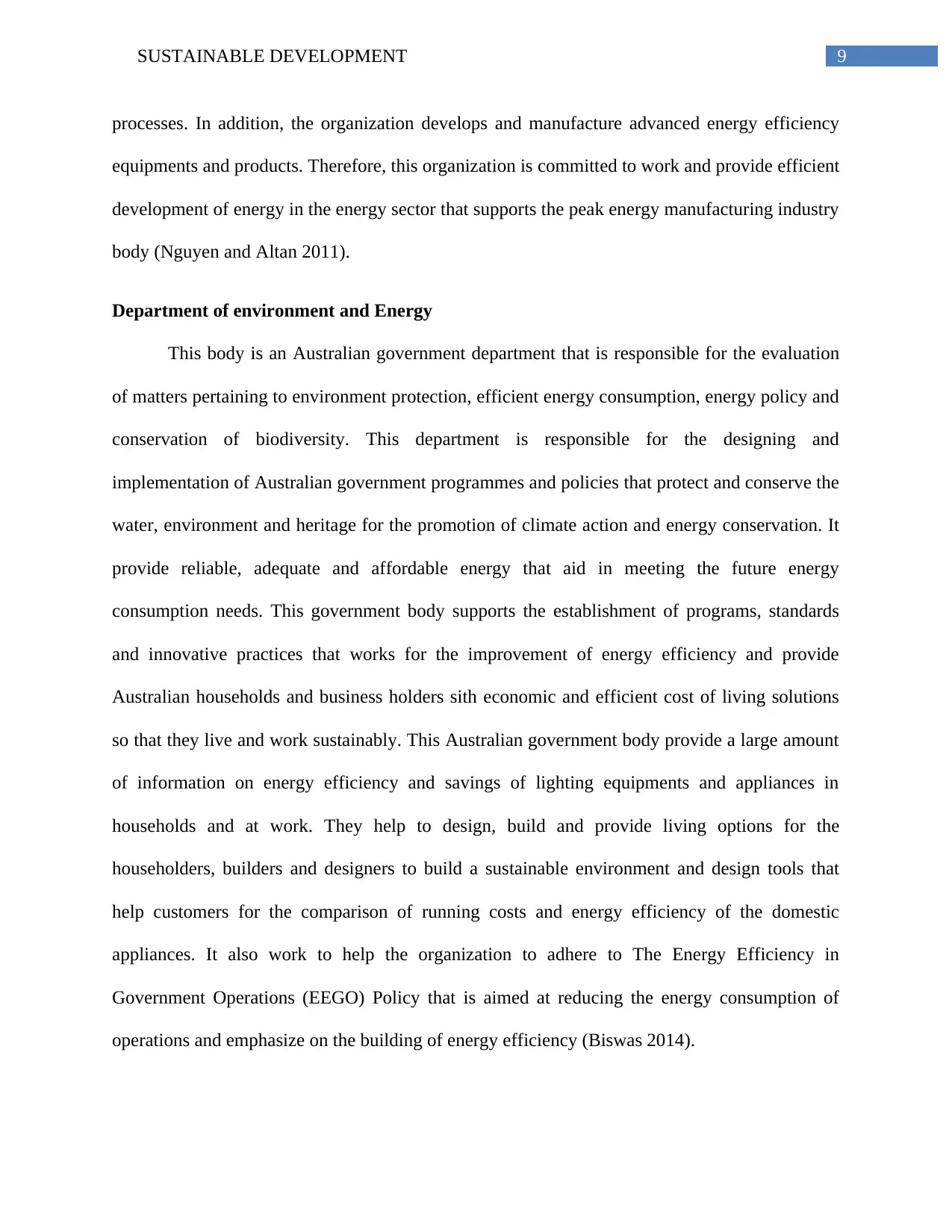
9SUSTAINABLE DEVELOPMENT
processes. In addition, the organization develops and manufacture advanced energy efficiency
equipments and products. Therefore, this organization is committed to work and provide efficient
development of energy in the energy sector that supports the peak energy manufacturing industry
body (Nguyen and Altan 2011).
Department of environment and Energy
This body is an Australian government department that is responsible for the evaluation
of matters pertaining to environment protection, efficient energy consumption, energy policy and
conservation of biodiversity. This department is responsible for the designing and
implementation of Australian government programmes and policies that protect and conserve the
water, environment and heritage for the promotion of climate action and energy conservation. It
provide reliable, adequate and affordable energy that aid in meeting the future energy
consumption needs. This government body supports the establishment of programs, standards
and innovative practices that works for the improvement of energy efficiency and provide
Australian households and business holders sith economic and efficient cost of living solutions
so that they live and work sustainably. This Australian government body provide a large amount
of information on energy efficiency and savings of lighting equipments and appliances in
households and at work. They help to design, build and provide living options for the
householders, builders and designers to build a sustainable environment and design tools that
help customers for the comparison of running costs and energy efficiency of the domestic
appliances. It also work to help the organization to adhere to The Energy Efficiency in
Government Operations (EEGO) Policy that is aimed at reducing the energy consumption of
operations and emphasize on the building of energy efficiency (Biswas 2014).
processes. In addition, the organization develops and manufacture advanced energy efficiency
equipments and products. Therefore, this organization is committed to work and provide efficient
development of energy in the energy sector that supports the peak energy manufacturing industry
body (Nguyen and Altan 2011).
Department of environment and Energy
This body is an Australian government department that is responsible for the evaluation
of matters pertaining to environment protection, efficient energy consumption, energy policy and
conservation of biodiversity. This department is responsible for the designing and
implementation of Australian government programmes and policies that protect and conserve the
water, environment and heritage for the promotion of climate action and energy conservation. It
provide reliable, adequate and affordable energy that aid in meeting the future energy
consumption needs. This government body supports the establishment of programs, standards
and innovative practices that works for the improvement of energy efficiency and provide
Australian households and business holders sith economic and efficient cost of living solutions
so that they live and work sustainably. This Australian government body provide a large amount
of information on energy efficiency and savings of lighting equipments and appliances in
households and at work. They help to design, build and provide living options for the
householders, builders and designers to build a sustainable environment and design tools that
help customers for the comparison of running costs and energy efficiency of the domestic
appliances. It also work to help the organization to adhere to The Energy Efficiency in
Government Operations (EEGO) Policy that is aimed at reducing the energy consumption of
operations and emphasize on the building of energy efficiency (Biswas 2014).
Paraphrase This Document
Need a fresh take? Get an instant paraphrase of this document with our AI Paraphraser
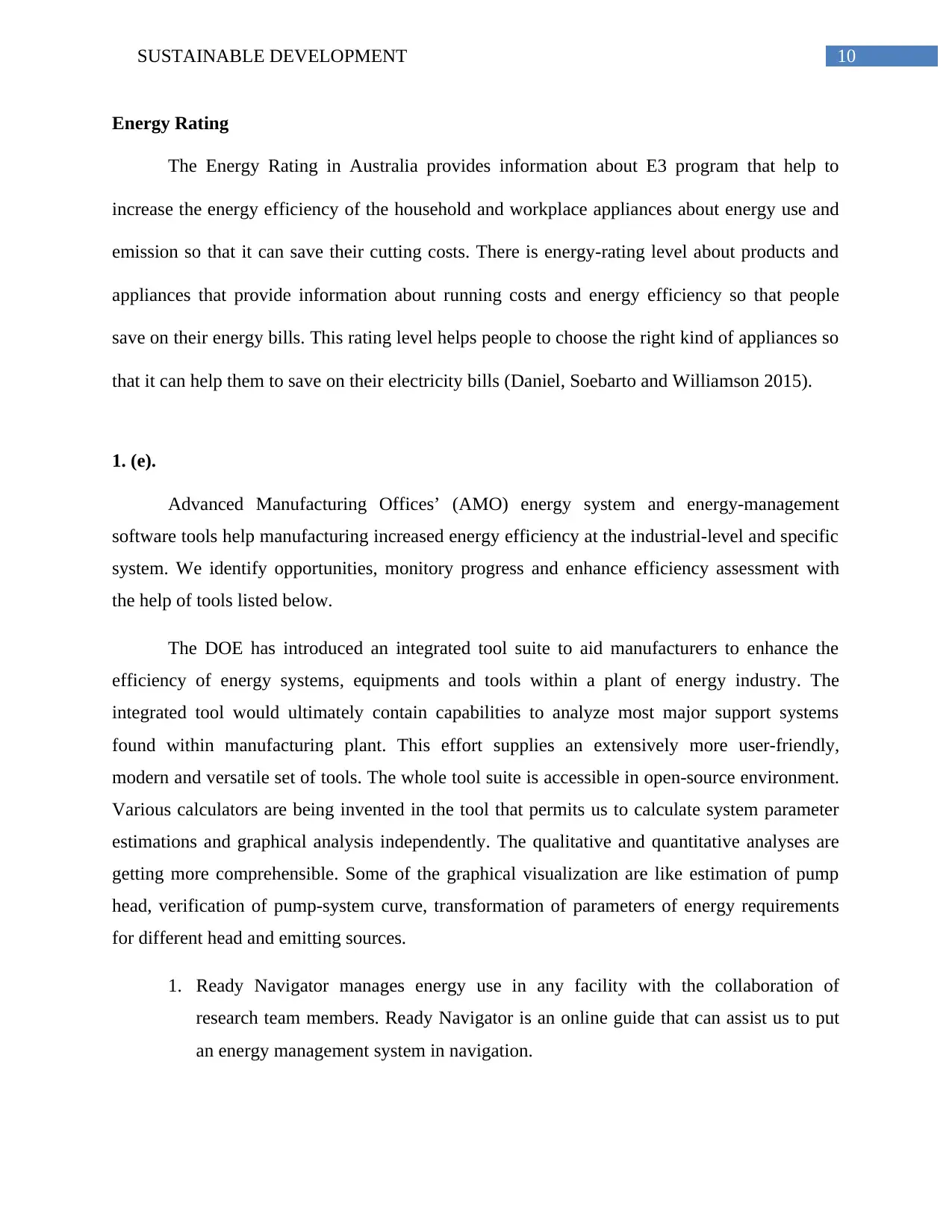
10SUSTAINABLE DEVELOPMENT
Energy Rating
The Energy Rating in Australia provides information about E3 program that help to
increase the energy efficiency of the household and workplace appliances about energy use and
emission so that it can save their cutting costs. There is energy-rating level about products and
appliances that provide information about running costs and energy efficiency so that people
save on their energy bills. This rating level helps people to choose the right kind of appliances so
that it can help them to save on their electricity bills (Daniel, Soebarto and Williamson 2015).
1. (e).
Advanced Manufacturing Offices’ (AMO) energy system and energy-management
software tools help manufacturing increased energy efficiency at the industrial-level and specific
system. We identify opportunities, monitory progress and enhance efficiency assessment with
the help of tools listed below.
The DOE has introduced an integrated tool suite to aid manufacturers to enhance the
efficiency of energy systems, equipments and tools within a plant of energy industry. The
integrated tool would ultimately contain capabilities to analyze most major support systems
found within manufacturing plant. This effort supplies an extensively more user-friendly,
modern and versatile set of tools. The whole tool suite is accessible in open-source environment.
Various calculators are being invented in the tool that permits us to calculate system parameter
estimations and graphical analysis independently. The qualitative and quantitative analyses are
getting more comprehensible. Some of the graphical visualization are like estimation of pump
head, verification of pump-system curve, transformation of parameters of energy requirements
for different head and emitting sources.
1. Ready Navigator manages energy use in any facility with the collaboration of
research team members. Ready Navigator is an online guide that can assist us to put
an energy management system in navigation.
Energy Rating
The Energy Rating in Australia provides information about E3 program that help to
increase the energy efficiency of the household and workplace appliances about energy use and
emission so that it can save their cutting costs. There is energy-rating level about products and
appliances that provide information about running costs and energy efficiency so that people
save on their energy bills. This rating level helps people to choose the right kind of appliances so
that it can help them to save on their electricity bills (Daniel, Soebarto and Williamson 2015).
1. (e).
Advanced Manufacturing Offices’ (AMO) energy system and energy-management
software tools help manufacturing increased energy efficiency at the industrial-level and specific
system. We identify opportunities, monitory progress and enhance efficiency assessment with
the help of tools listed below.
The DOE has introduced an integrated tool suite to aid manufacturers to enhance the
efficiency of energy systems, equipments and tools within a plant of energy industry. The
integrated tool would ultimately contain capabilities to analyze most major support systems
found within manufacturing plant. This effort supplies an extensively more user-friendly,
modern and versatile set of tools. The whole tool suite is accessible in open-source environment.
Various calculators are being invented in the tool that permits us to calculate system parameter
estimations and graphical analysis independently. The qualitative and quantitative analyses are
getting more comprehensible. Some of the graphical visualization are like estimation of pump
head, verification of pump-system curve, transformation of parameters of energy requirements
for different head and emitting sources.
1. Ready Navigator manages energy use in any facility with the collaboration of
research team members. Ready Navigator is an online guide that can assist us to put
an energy management system in navigation.
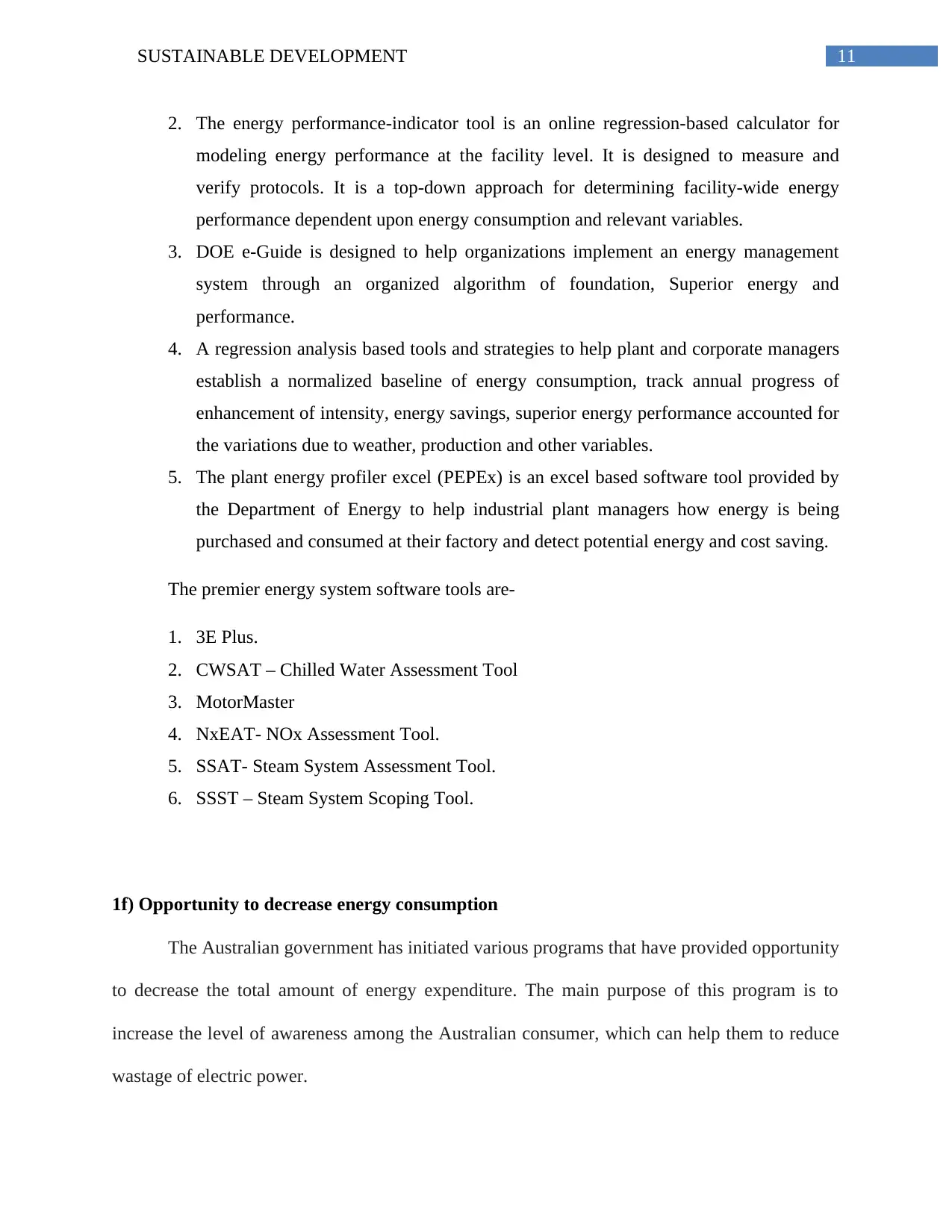
11SUSTAINABLE DEVELOPMENT
2. The energy performance-indicator tool is an online regression-based calculator for
modeling energy performance at the facility level. It is designed to measure and
verify protocols. It is a top-down approach for determining facility-wide energy
performance dependent upon energy consumption and relevant variables.
3. DOE e-Guide is designed to help organizations implement an energy management
system through an organized algorithm of foundation, Superior energy and
performance.
4. A regression analysis based tools and strategies to help plant and corporate managers
establish a normalized baseline of energy consumption, track annual progress of
enhancement of intensity, energy savings, superior energy performance accounted for
the variations due to weather, production and other variables.
5. The plant energy profiler excel (PEPEx) is an excel based software tool provided by
the Department of Energy to help industrial plant managers how energy is being
purchased and consumed at their factory and detect potential energy and cost saving.
The premier energy system software tools are-
1. 3E Plus.
2. CWSAT – Chilled Water Assessment Tool
3. MotorMaster
4. NxEAT- NOx Assessment Tool.
5. SSAT- Steam System Assessment Tool.
6. SSST – Steam System Scoping Tool.
1f) Opportunity to decrease energy consumption
The Australian government has initiated various programs that have provided opportunity
to decrease the total amount of energy expenditure. The main purpose of this program is to
increase the level of awareness among the Australian consumer, which can help them to reduce
wastage of electric power.
2. The energy performance-indicator tool is an online regression-based calculator for
modeling energy performance at the facility level. It is designed to measure and
verify protocols. It is a top-down approach for determining facility-wide energy
performance dependent upon energy consumption and relevant variables.
3. DOE e-Guide is designed to help organizations implement an energy management
system through an organized algorithm of foundation, Superior energy and
performance.
4. A regression analysis based tools and strategies to help plant and corporate managers
establish a normalized baseline of energy consumption, track annual progress of
enhancement of intensity, energy savings, superior energy performance accounted for
the variations due to weather, production and other variables.
5. The plant energy profiler excel (PEPEx) is an excel based software tool provided by
the Department of Energy to help industrial plant managers how energy is being
purchased and consumed at their factory and detect potential energy and cost saving.
The premier energy system software tools are-
1. 3E Plus.
2. CWSAT – Chilled Water Assessment Tool
3. MotorMaster
4. NxEAT- NOx Assessment Tool.
5. SSAT- Steam System Assessment Tool.
6. SSST – Steam System Scoping Tool.
1f) Opportunity to decrease energy consumption
The Australian government has initiated various programs that have provided opportunity
to decrease the total amount of energy expenditure. The main purpose of this program is to
increase the level of awareness among the Australian consumer, which can help them to reduce
wastage of electric power.
⊘ This is a preview!⊘
Do you want full access?
Subscribe today to unlock all pages.

Trusted by 1+ million students worldwide
1 out of 16
Your All-in-One AI-Powered Toolkit for Academic Success.
+13062052269
info@desklib.com
Available 24*7 on WhatsApp / Email
![[object Object]](/_next/static/media/star-bottom.7253800d.svg)
Unlock your academic potential
Copyright © 2020–2025 A2Z Services. All Rights Reserved. Developed and managed by ZUCOL.
